To say I’ve been thinking for a long time about what the best tree for a beginner is, is an understatement. Then, some recent comments on one of my posts prompted me into some research and, now, full of myself, I will boldly give you my “oh peen yon”. I hope I don’t annoy anyone. Actually, I don’t, but I probably will, so, sorry, dudes.
Here’s a rudimentary list.
1. Juniper
2. Elm
3. Ficus
4. Serissa
5.money tree
6. schefflera
7. Fukien tea
I did some surfing on the web and picked the most common.
So, there could be more (like podocarpus, but that’s an unusual one ) but we will stick with these I thinketh.
Let’s weed out some.
I don’t think many would object to removing the money tree (#5) from the list. It is common on websites selling beginner trees. But I would combine them (along with lucky bamboo and topiaries) into the category of “aesthetic plants”.
I will also (and this be many peoples opinion matey), take off the schefflera. It is an easy tree, but it’s not very convincing as a tree until you get into the larger specimens. And beginners can’t afford larger specimens. Heck, I can’t afford them.
So the list is now:
1. Juniper
2. Elm
3. Ficus
4. Serissa
5. Fukien tea
Let’s start at 5 and go backwards ( it is opposite day)
The Fukien tea. It’s also called Fujian tea, which is the modern spelling of the Chinese province. So it is more correct. But Fukien tea sounds so much better out loud. Go ahead, say it.
Wait! It gets more complicated from here.
The Latin, botanical name used to be carmona microphylla. Then, typically, (the field of taxonomy is peopled by bullies. Whosoever speaks the loudest and longest gets to name a thing.) someone changed it to ehretia buxifolia. (I don’t know why. A plant is classified by it’s flower. Hence, a poinsettia is the same genus as a candelabra euphorbia.
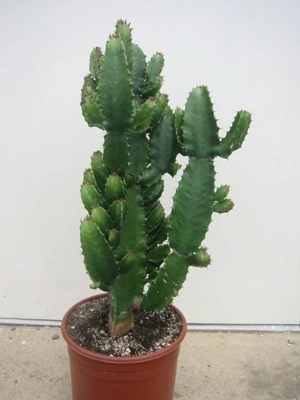
Candelabra euphorbia
If you compare an ehretia flower and carmona flower they are not similar.)
By the way, it is now called carmona retusa. Don’t believe me? Look it up, Spanky.
Anyhow, where was I?
The Fukien tea is a good beginner tree. It is inexpensive, easy to care for and has few pests. It is a tropical though, but can tolerate being indoors.
(a short note on that. The biggest misconception about bonsai is that they are houseplants. That you can put them on your desk and contemplate them between stressful phone calls. In the ideal situation, a bonsai tree is a tree. Trees live outside. Sometimes, climate zones do not favor a particular tree in a particular zone (seasonally). This is when we protect them and bring them inside. But they grow better outside. They do…really. )
Most fukiens come in an S curved shape (as do a lot of beginner trees so fear not)

The reason is twofold. One, it’s supposed to resemble a Chinese dragon. The other is, its an easier cultivation technique. They take a young, flexible tree, tie is to a piece of bamboo, and scrunch it down. Easy peasy. (When one is creating millions of trees the use of this technique may be lacking in finesse, but its very efficient). My advice is, look for the ones with irregular patterns. You’ll find one, try harder.
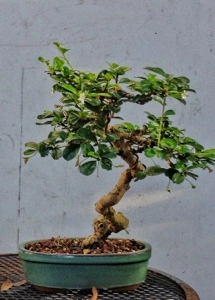
Like that.
# 4. Serissa foetida. Tree of a thousand stars, snow rose etc.
There are many cultivars with different leaves or flowers. Some more dwarf than others.
This is a sub-tropical tree. Which means I (in Orlando) can leave it out year round. Maybe not you though. The literature says that the regular species (light green leaf, white flower) can tolerate temperatures down to 9-ish Celsius : 14-ish Fahrenheit. I’ve had no problem with them getting freeze damage here in Orlando.
There are reports of them being semi-deciduous in colder climates.
Regardless of this, I find serissas not to be a good plant for beginners. They die easily.
The overwhelming reason they are sold is this:
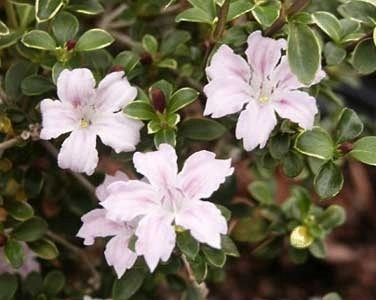
Pure pornography! Filth!
They are sold in the S shape too

I’ll show you when we get to the elm what to do with the S shape.
The largest problem with the serissa is this: they drop their leaves at the least provocation. Change in location, too much water, not enough water, voting across party lines…..
When they drop leaves, they will, if overwatered, rot at the roots ( Why? The mechanism for moving water from the roots to the leaves is called transpiration. It is good horticulture practice to withhold water (mostly,they can’t get bone dry) on a tree without leaves. See my portulacaria post for an in-depth explanation of transpiration.)
Many people have killed one of these trees. Sad, really. It’s more of an intermediate level tree.
Número tres.
Ficus.
There are so many species of ficus one could make a career describing them. And growing them for bonsai. I suggest looking at Jerry Meislik’s website for an in depth education. And seek out his book “Ficus: The Exotic Bonsai”

Great read.
The most common ficus you will see for sale is the “weeping fig” ficus benjamina. Which, in my opinion, is the most difficult (this seems to be a theme with beginner plants, hmmmn) . If you prune a branch, and don’t leave a growing tip, that branch will tend to die.
It is also the most apt to get (in my greenhouse at least) the dreaded Cuban Laurel Thrip.
They, also, will drop leaves at the, ah, drop of a hat. And they are susceptible to a fungal or viral infection call a “gall”

Ugly, but it won’t kill the tree.
The ficus I recommend to beginners the most is the ficus microcarpa. Any species like retusa or green island or any such broadleaf ficus. The big leaf is good in lower light levels (like your office desk) and its pretty forgiving when it comes to pruning and watering.
The willow leaf ficus (f. Salicaria ) is an ideal beginner tree except for one small detail. It grows too much. When you do a hard pruning on a salicaria the tree will respond with copious growth. So much that the area you just pruned will lose shape quickly. I don’t think a beginner can keep up with it.
On to number two. Chinese elm. Ulmus parviflora.
Of all these trees I like the elm best for beginners in colder climates.
Except for snow load or freezing pots, the elm can survive outside in freezing temps. It can take heat and humidity as well, it thrives here in Florida.
It has a small leaf that reduces further upon trimming, it buds back profusely and predictably, and it grows quickly.
The S curve style is the most prevalent in this species when you are looking for one to buy.
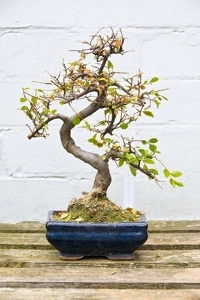
But, with a little taste and distinction, you canput lipstick on a pig.

This is just a wiring job but it looks decent.
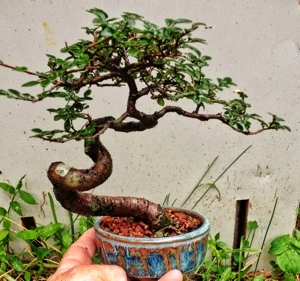
This one was handpicked for the special movement it had.

This one was cut to the first branch, which then became the leader.

As was done with this cute little one too.
As you might be able to tell, I like the Chinese elm. I believe we haven’t seen the full potential of what can be done with them yet. They are an unexplored tree even with how common they are. It’s like people can’t see the tree for the forest… Sorry, that was a bad one.
I find them just as plastic (malleable) as a juniper or a ficus;very tough and forgiving too. Fast growing and easily maintained.
I do believe they deserve their own post. I keep making more work for myself.
And now to number one:
The juniper. If we were counting, there have been more juniper deaths in the bonsai world than any tree, ever. Even the Japanese had a wholesale slaughter of them learning how to collect the juniper properly from the mountains. Poor, poor trees.
Whenever I do a meet n’ greet with the general public, it is almost a litany for the jaded plantsman (or woman) to approach the table and (with varying attitudes; from pride to guilt) say,
” I had one of those and it died (or killed it, or the neighbor killed it, or I went on vacation,
ad infinitum)”
I do not recommend the juniper to a novice. Period.
That’s not to say that a novice can’t be successful with one. But to sell the juniper as a person’s first tree is a little negligent.
One, the likelihood of it dying is close to 80%. People bring it inside,set it on the TV or such, don’t water it, etc. You have heard all the stories.
Two, they are picky when you -fill in the blank- (repot them, wire them, trim them, water them, insult them )
That groan youre hearing is the collective grumbling of all the juniper advocates (or snobs) are saying “you just have to learn how…..”
Listen, the idea of a beginner tree is to give the novice something that is easy to care for and will encourage them to learn more about the art.
If more vendors would resist that quick buck and realize that if you teach the man to fish, he will buy your trees. (a mixed metaphor is like a mixed drink. I don’t know where to go with that one. Sorry). If you sell him one that lives he will buy more from you.
Now don’t get me wrong, it is important to learn how to grow a juniper bonsai. But that should come later.
I think that’s all I have to say about that.
So here is revised list from best to worst.
1. Ficus
2. Chinese elm
3. Fukien tea
4. Serissa
5. Juniper
I’m sure there will be some dissenters to the order and tree selection. One cannot please everyone.
I like this order, I think it will stand up to many arguments and challenges.
Here are some glamor shots to say goodbye





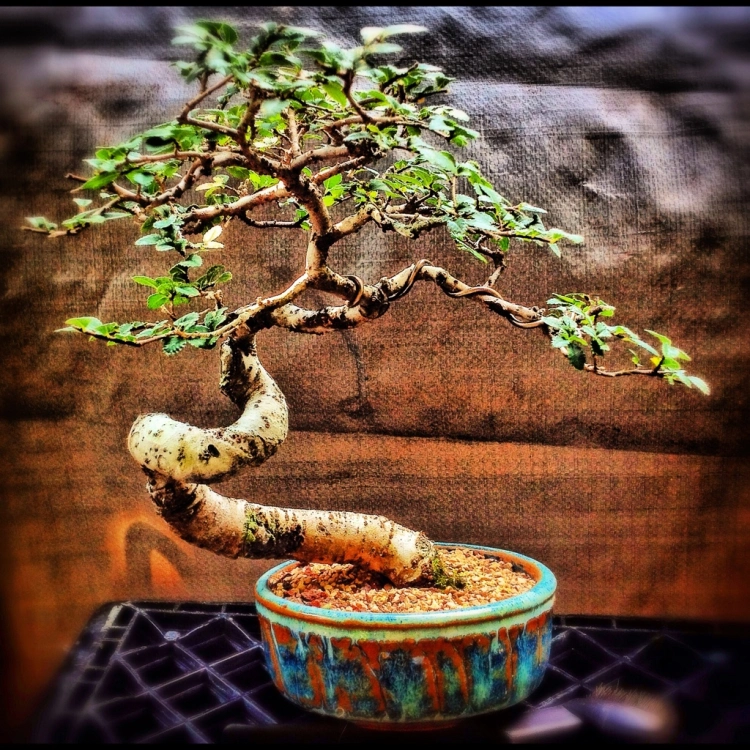

I like your order….works for me. I must say I have seen (created) some nice little clumps of aboricola (dwarf shefflera) in a shallow tray…………..I think it is a good look and super easy to care for. Adam, your blog is stellar. Almost motivates me to put down the floggin’ sticks and get back in the garden………………………..owo
LikeLike
Thanks Rick. I always appreciate a comment from you.
As a forest or a large tree the schefflera is an ideal tree. But as a single tree ($25 or so) there’s not much to do to it to learn.
I am not one to discount them as bonsai material either. I like them myself.
Anyway, stay out of the rough and watch out for them gators
LikeLike
Just my 2cents-
I agree with 1-3 but not 4 & 5. Juniper may go well on the list as a rite of passage, aka “the first tree I killed”. Serissas are just bitchy as far as plants/trees go.
Scheffleras should stay on the list. They’re hearty, can live both indoors and outdoors and grow relatively fast, good for the beginner.
Chinese Elm is by far #1 for any level of bonsai.
It’s worth noting that 3/5 of the list has a tropical tint to it.
LikeLike
I was taking the more common choices and dissecting them. I certainly don’t recommend the last two either but if I didn’t explain the pros and cons I would have been summarily dismissed as a blowhard.
There have been more suggestions (some I’m not at liberty to print; something about where the sun don’t shine) but mostly they’ve been constructive.
LikeLike
I would put Chinese Elm at number one, but really I think your list is fine. Great run down! The first two trees I ever killed were Junipers. Then a few serissas followed.
LikeLike
I think the list is perfect!! Being a beginner I’ve allready killed my quota of juniper and now can make them survive with alot and I mean alot of studying. I no longer will give them as presents to people I’m trying to get into bonsai. I go with Fukien tea or elm. Fukien tea only because I live in Fl. And they love it here.
LikeLike
Great list. I started with a Juniper when I worked with my first teacher 20 years ago. Still alive today and doing well. They are forgiving, shape easily and are hard to kill!
LikeLike
I’m rereading through the beginning of the blog and have started my adventure in Bonsai. A little magical that this blog on beginner advice was published on my birthday. Thanks!
LikeLike
Reblogged this on Wolf's Birding and Bonsai Blog.
LikeLike
Hi Adam, great blog. I have learned loads of your lessions. thanks
Do you have any list of most difficult ones?
LikeLike
Adam your blog was very instructive to a beginner. I’ve been drooling over a Japanese black pine bonsai on ebay but after reading your post I’m on Pause. I don’t want to kill it (80% chance…). I guess I better concentrate on keeping my Chinese Dawn Redwood & Dwarf Pyracantha alive (gulp).
LikeLike
I have 3 small nursery bought F. Salicaria, and I’m thoroughly enjoying the plants. I’ve killed enough juniper to set them aside for the time being and focus on tropical and sub tropicals. Anyway, thanks for the large coverage of ficus bonsai. It has helped a lot already!
LikeLike
Seems a running theme here, but I’ll post it mostly to reinforce the rock-star part of your brain (and to feel a little better about myself as a Juniper assassin).
1) I stumbled on your blog while looking for images of Willow-leaf. I’m glad I stayed
2) Darn you for reminding me that I can’t wire and trim my entire little collection every day! I want beautiful top-notch, show-stopping trees, and “I want them now, Daddy!” (try hearing that in my most convincing Veruca Salt impersonation)
3) Thanks for being so kind. As an enthusiastic novice, your light-hearted, quick-witted, informative style takes away most of the overwhelming fear I have about this. I grew up in Florida, so I have some intuitive understanding of the tropical. Now I live in Ohio. I’m having a hard time trusting that the trees will wake back up in the spring after the long winter nap. Lots to learn about that still.
I’m sure I’ll respond more. This is good stuff. Like my new-ish commitment to the art. I am taking the blog slow, and from the start. I am looking forward to reading you take on fertilization (nudge, nudge, wink wink)
Also, I seemed to have lucked out. 4 of the 5 above are in my little collection. The serissa is brand new, and I’m still learning ton listen to what it’s saying, which kinda sucks, because it’s really just whispering at this time of year on Toledo The other three are a dwarf pomegranate, a BRT, and the ubiquitous podocarpus (my first return to “pointy-leaved” plants since the ghosts of Junipers past have begun to allow me to sleep at night). Thanks again for your willingness to share.
LikeLike
I have heard mixed opinions about keeping a Chinese elm indoors. I am aware that almost all bonsai prefer at least some, if not all outdoor living. I recently got a corner office with south and west facing windows, and no outdoor access. I bought a dwarf schefflera and it is doing well, but I want more trees, most especially a Chinese elm. Given my south and west facing windows (high up too, no blockers to the sun) do you think a Chinese elm would do well?
LikeLike